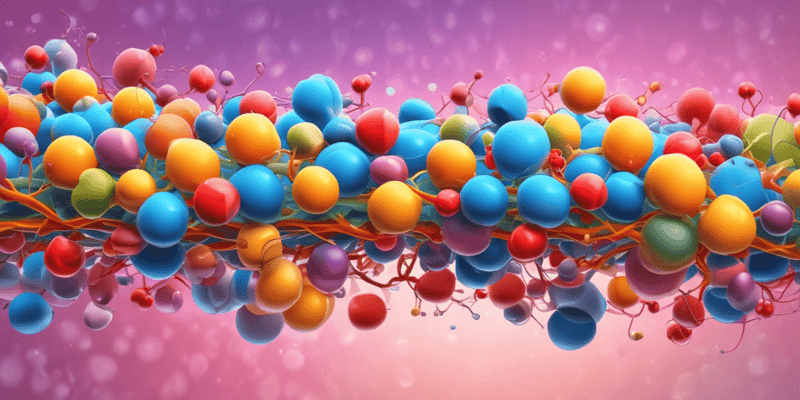11 Questions
What is the primary function of the GLUT transporters?
To transport glucose into and out of cells
Which enzyme catalyzes the irreversible conversion of fructose 6-phosphate to fructose 1,6-bisphosphate?
Phosphofructokinase-1
What is the primary function of Glyceraldehyde 3-phosphate dehydrogenase?
To convert G3P into 1,3-bisphosphoglycerate, producing NADH and ATP
How many ATP molecules are produced overall through the action of Phosphoglycerate kinase?
2
What is the role of the Kinase enzyme in glycolysis?
To phosphorylate ADP to produce ATP, using 1,3-BPG as a substrate
Which enzyme catalyzes the conversion of glucose 6-phosphate to fructose 6-phosphate through isomerization?
Phospho hexose isomerase
What enzyme is involved in converting 3-phosphoglycerate to 2-phosphoglycerate?
Phosphoglycerate mutase
What is the net ATP production from the glycolysis pathway?
2 ATP
Which of the following statements about lactate dehydrogenase is correct?
Lactate dehydrogenase is involved in the conversion of pyruvate to lactic acid.
What is the final product of the glycolysis pathway?
Pyruvate
Which of the following statements about the conversion of 2-phosphoglycerate to phosphoenolpyruvate (PEP) is correct?
The conversion is catalyzed by the enolase enzyme.
Study Notes
- Glycolysis is the process of oxidizing glucose, a six-carbon molecule, through about ten steps to eventually convert it into pyruvate.
- Glucose is brought into cells through specialized transporters called GLUT transporters, which are bidirectional and can move glucose in and out of cells.
- Different organs have different types of GLUT receptors, categorized by helpful mnemonics like "BBB" for blood-brain barrier.
- GLUT4 is insulin-dependent, which means its activity is regulated by the presence of insulin, unlike other GLUT transporters.
- Glucose is converted to glucose 6-phosphate by enzymes like hexokinase and glucokinase, using ATP to add a phosphate group to glucose.
- Phospho hexose isomerase catalyzes the conversion of glucose 6-phosphate to fructose 6-phosphate through isomerization.
- Phosphofructokinase-1 catalyzes the irreversible conversion of fructose 6-phosphate to fructose 1,6-bisphosphate, using ATP to add a phosphate group.
- Aldolase enzyme cleaves fructose 1,6-bisphosphate into DHAP and G3P, with triose phosphate isomerase converting DHAP to G3P.
- Glyceraldehyde 3-phosphate dehydrogenase converts G3P into 1,3-bisphosphoglycerate, producing NADH and ATP in the process.
- Phosphoglycerate kinase converts 3-phosphoglycerate to 2-phosphoglycerate, generating ATP, and the reaction occurs twice, producing two ATP molecules overall.- Kinase phosphorylates ADP to produce ATP, using 1,3-BPG as a substrate.
- 3-phosphoglycerate is converted to 2-phosphoglycerate in a non-significant reaction.
- Phosphoglycerate mutase enzyme is involved in converting 3-phosphoglycerate to 2-phosphoglycerate.
- 2-phosphoglycerate is converted to phosphoenolpyruvate (PEP) through an enol conversion.
- Enolase enzyme is involved in converting 2-phosphoglycerate to phosphoenolpyruvate.
- Pyruvate kinase converts phosphoenolpyruvate to pyruvate, generating ATP.
- Pyruvate can be converted to lactic acid during anaerobic conditions by lactate dehydrogenase.
- Lactate dehydrogenase enzyme is reversible, converting pyruvate to lactic acid.
- High levels of lactate dehydrogenase in the blood can indicate anaerobic conditions or certain medical conditions.
- Glycolysis occurs in the cytoplasm, starting with glucose and producing two pyruvates, 2 ATP (net), and 2 NADH.
Test your knowledge on the process of glycolysis, including steps from glucose conversion to pyruvate, enzymes involved, and key concepts like GLUT transporters, ATP production, and the regulation of insulin-dependent GLUT4. Explore the conversion of glucose to 1,3-bisphosphoglycerate and the role of enzymes like aldolase, phosphofructokinase-1, and pyruvate kinase.
Make Your Own Quizzes and Flashcards
Convert your notes into interactive study material.
Get started for free



